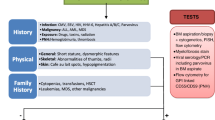Summary
Trephine bone marrow biopsy is a frequent routine investigation, particularly important in cases with an unsuccessful aspirate. In addition to a representative trephine biopsy length and quality, the patient's clinical history is of critical importance. Especially drug-induced bone marrow changes are often difficult to interpret without prior knowledge of exposure to respective agents. Since some of these changes mimic malignancies, this can lead to serious misinterpretations. Drugs in general can induce a wide spectrum of bone marrow reactions. Immunosuppressants such as Azathioprine and Methotrexate cause morphological bone marrow changes that can not be distinguished from myelodysplastic syndromes, while cytokines and growth factors induce an overall increase in cellularity and, in particular, a left shift of myelopoiesis with increased myeloblasts and monoblasts, mimicking acute myeloid leukaemia. Moreover, drugs with immuno-allergic- (such as Allopurinol, Carbimazole, Crabamazepine, Clozapine, non-steroidal anti-rheumatics, Phenytoin, Sulfonamides) or direct myelotoxic potential can lead either to T-cell-mediated bone marrow stem cell destruction with the morphological pattern of aplastic anaemia, to direct toxic or immunological burst- or colony-forming units' destruction with isolated erythro- or myelopoietic hypoplasias or to other changes such as eosinophilia, (haemo)phagocytosis, T-cell lymphocytosis (which can be very severe, resembling lymphoma/leukaemia), perivascular plasmacytosis, siderosis or stromal oedema. In summary, clinical information on drug exposure is at least as important as a good quality biopsy for comprehensive histology-based bone marrow diagnostics, hel** to avoid not only misinterpretation but also expensive additional examinations.
Similar content being viewed by others
References
Bain BJ, Clark DM, Lampert IA, Wilkins BS. Bone marrow pathology, 3rd edn. Blackwell, Oxford, 2001
Foucar K. Bone marrow pathology, 2nd edn. ASCP Press, Chicago, 2001
Fend F, Tzankov A, Bink K, Seidl S, et al. Modern techniques for the diagnostic evaluation of the trephine bone marrow biopsy: methodological aspects and applications. Prog Histochem Cytochem, 42: 203–252, 2008
Orazi A, O'Malley DP, Arber DA. Illustrated pathology of the bone marrow. Cambridge University Press, Cambridge, 2006
Campbell JK, Matthews JP, Seymour JF, Wolf MM, et al.; Australasian Leukaemia Lymphoma Group. Optimum trephine length in the assessment of bone marrow involvement in patients with diffuse large cell lymphoma. Ann Oncol, 14: 273–276, 2003
Cheson BD, Bennett JM, Kopecky KJ, Büchner T, et al. International Working Group for Diagnosis, Standardization of Response Criteria, Treatment Outcomes, and Reporting Standards for Therapeutic Trials in Acute Myeloid Leukemia. Revised recommendations of the International Working Group for Diagnosis, Standardization of Response Criteria, Treatment Outcomes, and Reporting Standards for Therapeutic Trials in Acute Myeloid Leukemia. J Clin Oncol, 21: 4642–4649
Schmidt B, Kremer M, Götze K, John K, et al. Bone marrow involvement in follicular lymphoma: comparison of histology and flow cytometry as staging procedures. Leuk Lymphoma, 47: 1857–1862, 2006
Wilkins BS, Clark DM. Making the most of bone marrow trephine biopsy. Histopathology, 55: 631–40, 2009
Salvador C, Steurer M, Tzankov A, Wolf AM, Gastl G, Konwalinka G, Wolf D. Naturally occurring CD4+ CD25+ regulatory T cells modulate the haematopoietic potential of human stem cells in vitro. Br J Haematol, 142: 845–847, 2008
Krech R, Thiele J. Histopathology of the bone marrow in toxic myelopathy. A study of drug induced lesions in 57 patients. Virchows Arch A Pathol Anat Histopathol, 405: 225–235, 1985
Corominas H, Baiget M. Clinical utility of thiopurine S-methyltransferase genoty**. Am J Pharmacogenomics, 4: 1–8, 2004
Swerdlow S, Campo E, Harris N, Jaffe E, et al. (eds). WHO classification of tumours of haematopoietic and lymphoid tissues, 4th edn. IARC, Lyon, pp. 88–93, 2008
Weyrich AS, Denis MM, Schwertz H, Tolley ND, Foulks J, Spencer E, Kraiss LW, Albertine KH, McIntyre TM, Zimmerman GA. mTOR-dependent synthesis of Bcl-3 controls the retraction of fibrin clots by activated human platelets. Blood, 109: 1975–1983, 2007
Liu CZ, Persad R, Inghirami G, Sen F, Amorosi E, Goldenberg A, Ibrahim S. Transient atypical monocytosis mimic acute myelomonocytic leukemia in post-chemotherapy patients receiving G-CSF: report of two cases. Clin Lab Haematol, 26: 359–362, 2004
Harris AC, Todd WM, Hackney MH, Ben-Ezra J. Bone marrow changes associated with recombinant granulocyte-macrophage and granulocyte colony-stimulating factors. Discrimination of granulocytic regeneration. Arch Pathol Lab Med, 118: 624–629, 1994
Douglas VK, Tallman MS, Cripe LD, Peterson LC. Thrombopoietin administered during induction chemotherapy to patients with acute myeloid leukemia induces transient morphologic changes that may resemble chronic myeloproliferative disorders. Am J Clin Pathol, 117: 844–850, 2002
Jonasch E, Haluska FG. Interferon in oncological practice: review of interferon biology, clinical applications, and toxicities. Oncologist, 6: 34–55, 2001
Brunner A, Kantner J, Tzankov A. Granulomatous reactions cause symptoms or clinically imitate treatment resistance in small lymphocytic lymphoma/chronic lymphocytic leukaemia more frequently than in other non-Hodgkin lymphomas. J Clin Pathol, 58: 815–819, 2005
Miescher PA. Blood dyscrasias secondary to non-steroidal anti-inflammatory drugs. Med Toxicol, 1(Suppl. 1): 57–70, 1986
Inman MD. Bone marrow events in animal models of allergic inflammation and hyperresponsiveness. J Allergy Clin Immunol, 106(Suppl. 5): S235–S241, 2000
Author information
Authors and Affiliations
Corresponding author
Rights and permissions
About this article
Cite this article
Hoeller, S., Tzankov, A. Consideration of exposure to pharmacological agents helps to avoid diagnostic pitfalls in bone marrow histopathology. memo 3, 132–135 (2010). https://doi.org/10.1007/s12254-010-0215-6
Received:
Accepted:
Published:
Issue Date:
DOI: https://doi.org/10.1007/s12254-010-0215-6




